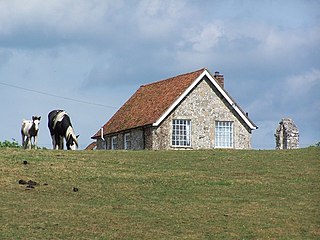
Malmesbury Abbey, at Malmesbury in Wiltshire, England, is a former Benedictine abbey dedicated to Saint Peter and Saint Paul. It was one of the few English religious houses with a continuous history from the 7th century through to the Dissolution of the Monasteries.

Clatford is a small hamlet approximately 1 mile (1.6 km) west of the village of Manton and about 2 miles (3.2 km) west of Marlborough, which is the nearest town, in Wiltshire, England. It is just south of the River Kennet and the A4 primary route.

Hullavington is a village and civil parish in Wiltshire, England, just to the north of the M4 motorway. The village lies about 4 miles (6 km) southwest of Malmesbury and 5+1⁄2 miles (9 km) north of Chippenham.

Ogbourne St Andrew is a civil parish and small village in Wiltshire, England, 2 miles (3.2 km) north of Marlborough. The parish is on the banks of the River Og and includes the hamlets of Ogbourne Maizey and Rockley.
Máel Dub was a Saint and reputed Irish monk of the 7th century, said to have founded a monastic house at Malmesbury, England.
Stanley Abbey was a medieval abbey near Chippenham, Wiltshire, England, which flourished between 1151 and 1536.

Malmesbury is a town and civil parish in north Wiltshire, England, which lies approximately 14 miles (23 km) west of Swindon, 25 miles (40 km) northeast of Bristol, and 9 miles (14 km) north of Chippenham. The older part of the town is on a hilltop which is almost surrounded by the upper waters of the Bristol Avon and one of its tributaries.
Avebury Priory was an alien house of Benedictine monks in Wiltshire, England, between the early 12th century and the Dissolution.
Clatford Priory, also called Hullavington Priory, was a priory in Wiltshire, England.

Ivychurch Priory was a medieval monastic house in Alderbury, southeast of Salisbury, Wiltshire, England. According to Historic England, "all that remains is a cylindrical pier with multi-scalloped capital and part of the double-chamfered arch with a respond to the west with a half-pier and capital; this is attached to the west wall of the church which retains one buttress".
The Priory of St Mary Magdalene was a Cluniac priory in Monkton Farleigh, Wiltshire, England, in the 12th to 16th centuries.
Ogbourne Priory was a priory in Wiltshire, England, from the 12th century until the early 15th.
Salisbury Black Friary was a friary in Wiltshire, England, in existence from 1281 to 1538.
Tisbury Grange was a priory in Wiltshire, England.
The Devizes County House of Corrections or Devizes Prison was a correctional facility in Devizes, Wiltshire, England. It opened in 1817, replacing the Old Bridewell prison, and fell out of use after around a hundred years. For a time it was the only prison in Wiltshire.

North Newnton is a civil parish in Wiltshire, England, 2.5 miles (4.0 km) southwest of Pewsey. The parish is in the Vale of Pewsey which carries the upper section of the Salisbury Avon.

Edith Weston Priory was a small alien house of Benedictine monks in Edith Weston, Rutland. The French parent house of Abbey of Saint-Georges, Boscherville was founded by Ralf de Tanquerville, chamberlain to William the Conqueror, about the year 1050. By 1114 his son William donated the church and manor at Edith Weston, and a small cell of monks was set up to collect the rents and intercede for the founder's soul.

Highway is a hamlet and former civil parish, now in the parish of Hilmarton, in Wiltshire, England. The hamlet lies about 1+1⁄2 miles (2.4 km) southeast of Hilmarton village and 3+1⁄2 miles (6 km) northeast of the town of Calne.
St Paul Malmesbury Without is a civil parish surrounding Malmesbury, Wiltshire, England. Its main settlements are the village of Corston and the hamlets of Milbourne and Rodbourne.

Lacock Abbey was a monastery founded at Lacock, in the county of Wiltshire in England, in the early 13th century by Ela, Countess of Salisbury, as a house of Augustinian Canonesses regular. It was seized by the crown in 1539 during the Dissolution of the Monasteries under Henry VIII. It then became a country house, Lacock Abbey, notable as the site of Henry Fox Talbot's early experiments in photography.











